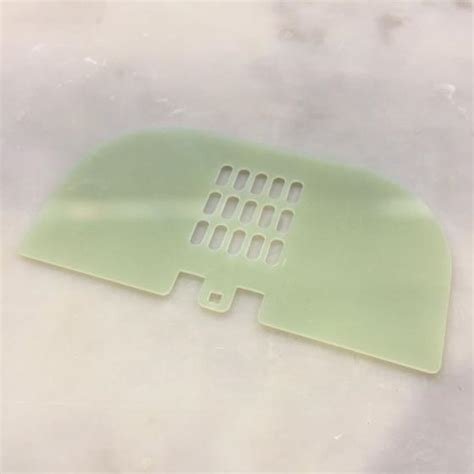Composition of FR4 fiberglass
FR4 laminate is composed of two main components:
- Fiberglass cloth: A woven fabric made from fine glass fibers, which acts as the reinforcement material.
- Epoxy resin: A thermosetting polymer that binds the fiberglass cloth layers together and provides insulation and mechanical strength.
The term “FR” in FR4 stands for “Flame Retardant,” indicating that the epoxy resin is mixed with flame-retardant chemicals, such as bromine or phosphorus compounds, to enhance its fire resistance properties.
Manufacturing Process of FR4 Fiberglass
The production of FR4 laminate involves several steps:
- Impregnation: The fiberglass cloth is impregnated with the epoxy resin mixture, ensuring that the resin thoroughly penetrates the fibers.
- Layup: Multiple layers of the impregnated fiberglass cloth are stacked together to achieve the desired thickness.
- Pressing: The stacked layers are placed in a heated press, where high temperature and pressure are applied to cure the epoxy resin and bond the layers together.
- Curing: The laminate is allowed to cool and fully cure, resulting in a solid, rigid sheet of FR4.
- Cutting and finishing: The cured FR4 sheet is cut to the desired size and shape, and any necessary surface treatments, such as copper cladding for PCBs, are applied.
Properties of FR4 Fiberglass
FR4 fiberglass exhibits several advantageous properties that make it an ideal material for various applications:
Mechanical Properties
- High strength-to-weight ratio
- Excellent dimensional stability
- Good impact resistance
- Low water absorption
| Property | Value |
|---|---|
| Density | 1.85 g/cm³ |
| Tensile strength | 310 MPa |
| Flexural strength | 415 MPa |
| Compressive strength | 415 MPa |
| Izod impact strength (notched) | 34 J/m |
| Water absorption (24 hours) | 0.15% |
Thermal Properties
- Good heat resistance
- Low thermal expansion
- Suitable for lead-free soldering processes
| Property | Value |
|---|---|
| Glass transition temperature (Tg) | 130-140°C |
| Decomposition temperature | >300°C |
| Thermal expansion coefficient (x-y plane) | 14-16 ppm/°C |
| Thermal expansion coefficient (z-axis) | 50-70 ppm/°C |
Electrical Properties
- Excellent dielectric properties
- High insulation resistance
- Low dielectric loss
| Property | Value |
|---|---|
| Dielectric constant (1 MHz) | 4.5-4.9 |
| Dielectric loss tangent (1 MHz) | 0.02 |
| Surface resistivity | 10^9-10^11 Ω |
| Volume resistivity | 10^10-10^12 Ω·m |
| Dielectric strength | 20-28 kV/mm |

Applications of FR4 Fiberglass
FR4 fiberglass finds use in various industries and applications, primarily in the electronics sector:
Printed Circuit Boards (PCBs)
FR4 is the most common base material for manufacturing PCBs, thanks to its excellent electrical insulation, mechanical strength, and thermal stability. It is used in:
- Single-sided, double-sided, and multi-layer PCBs
- High-frequency and high-speed digital circuits
- Aerospace, automotive, and industrial electronics
Structural Components
Due to its high strength-to-weight ratio and dimensional stability, FR4 is used in the construction of:
- Electrical enclosures and housings
- Brackets and supports
- Insulating washers and spacers
Automotive and Transportation
FR4 finds applications in the automotive and transportation industries, such as:
- Electrical insulation in vehicles
- Printed circuit boards for automotive electronics
- Structural components in aircraft interiors
Frequently Asked Questions (FAQ)
1. What does the “FR” in FR4 stand for?
The “FR” in FR4 stands for “Flame Retardant.” This indicates that the epoxy resin used in the laminate contains flame-retardant additives, such as bromine or phosphorus compounds, which enhance the material’s fire resistance properties.
2. Is FR4 fiberglass suitable for lead-free soldering?
Yes, FR4 fiberglass is suitable for lead-free soldering processes. Its glass transition temperature (Tg) of 130-140°C allows it to withstand the higher temperatures required for lead-free soldering without significant degradation of its properties.
3. Can FR4 be used for high-frequency applications?
FR4 is commonly used in high-frequency and high-speed digital circuits. However, for very high-frequency applications (above 1 GHz), specialized materials with lower dielectric constants and loss tangents, such as Rogers or Teflon-based laminates, may be preferred.
4. How does FR4 compare to other PCB materials?
Compared to other PCB materials, such as CEM-1 or CEM-3, FR4 offers superior mechanical strength, thermal stability, and electrical properties. However, it is more expensive than these alternatives. For high-frequency applications, materials like Rogers or Teflon-based laminates may be more suitable due to their lower dielectric constants and loss tangents.
5. What are the main advantages of using FR4 fiberglass?
The main advantages of using FR4 fiberglass include:
- Excellent electrical insulation properties
- High mechanical strength and dimensional stability
- Good thermal resistance and suitability for lead-free soldering
- Flame retardancy, enhancing safety in electrical applications
- Versatility in terms of application areas, from PCBs to structural components
In conclusion, FR4 fiberglass is a versatile and widely used material in the electronics industry, particularly in the manufacturing of printed circuit boards. Its combination of excellent mechanical, thermal, and electrical properties, along with its flame retardancy, makes it an ideal choice for a wide range of applications. As technology continues to advance, FR4 remains a reliable and essential material in the world of electronics.

No responses yet